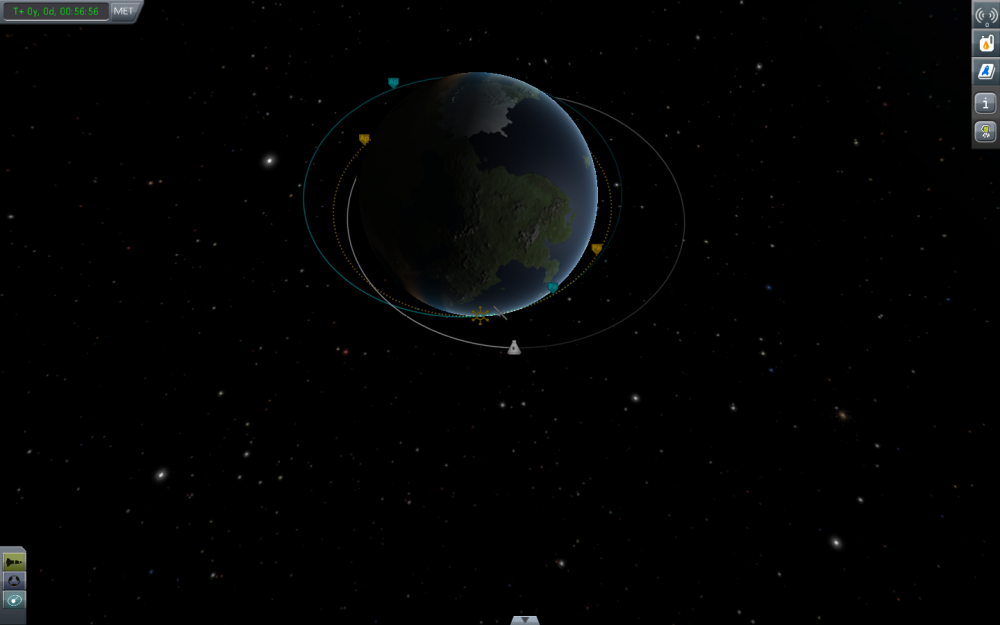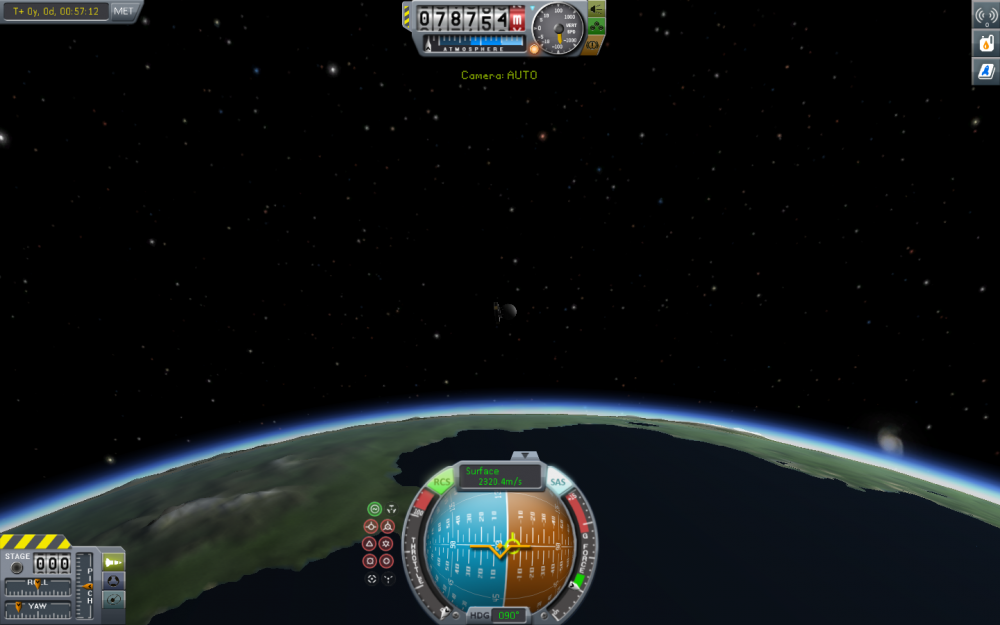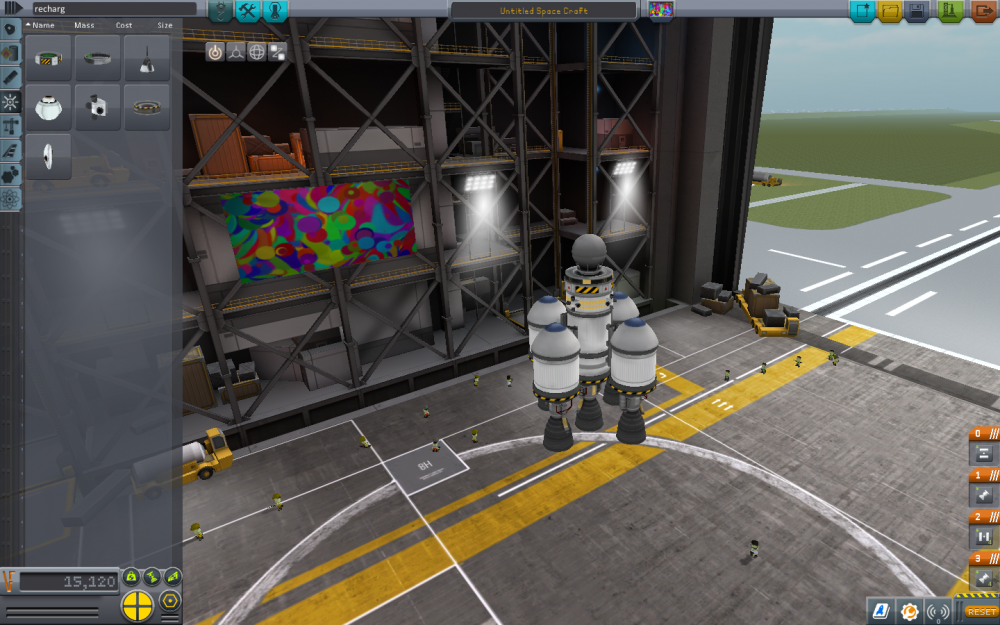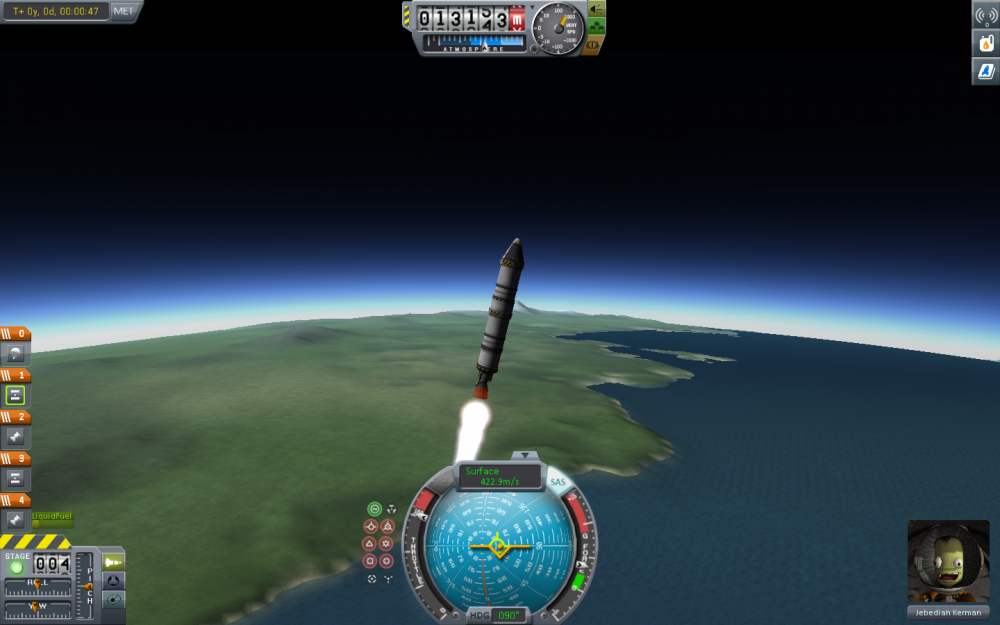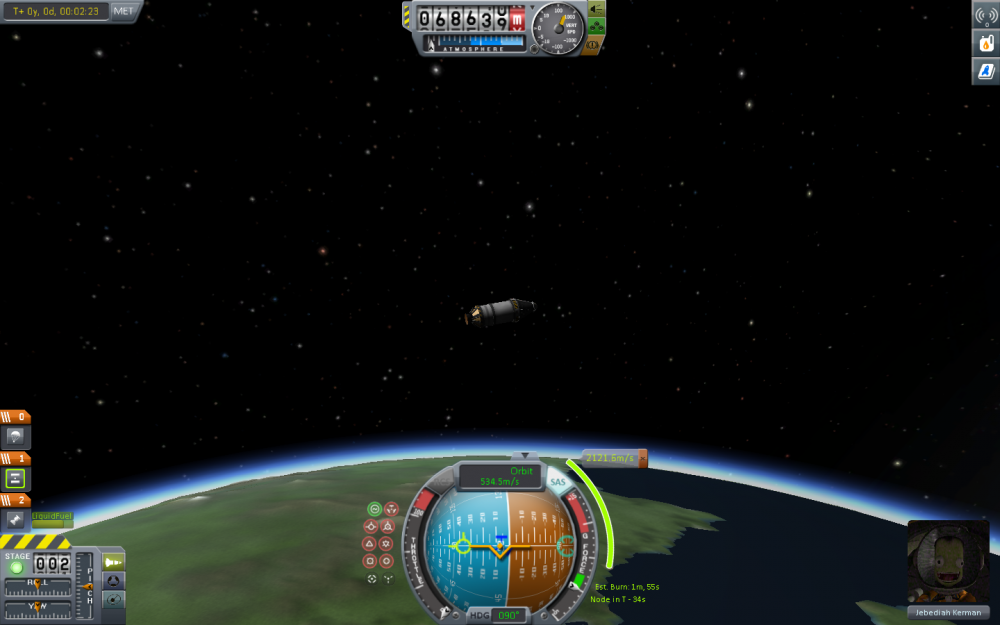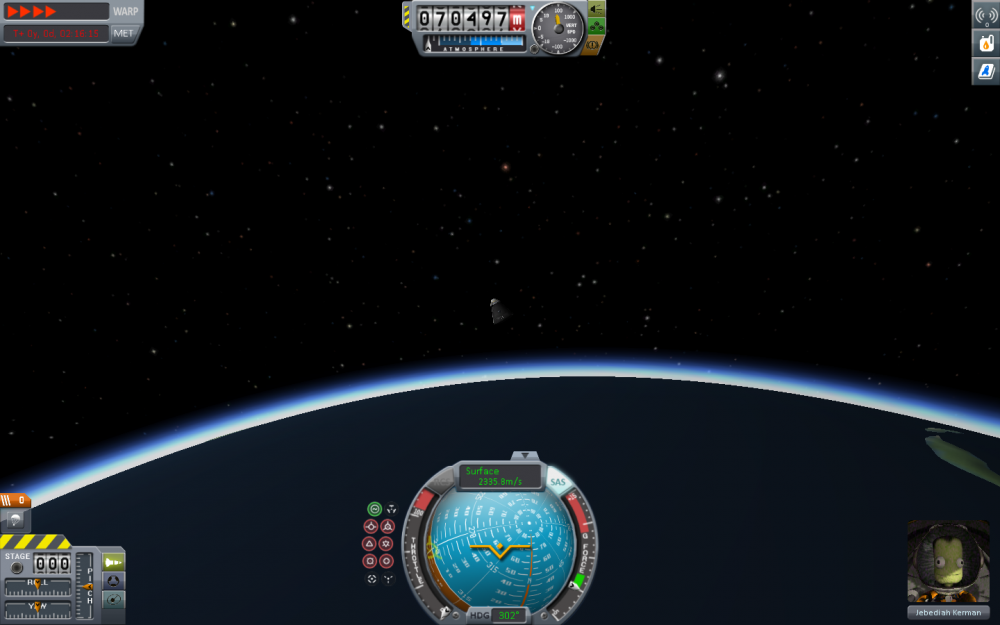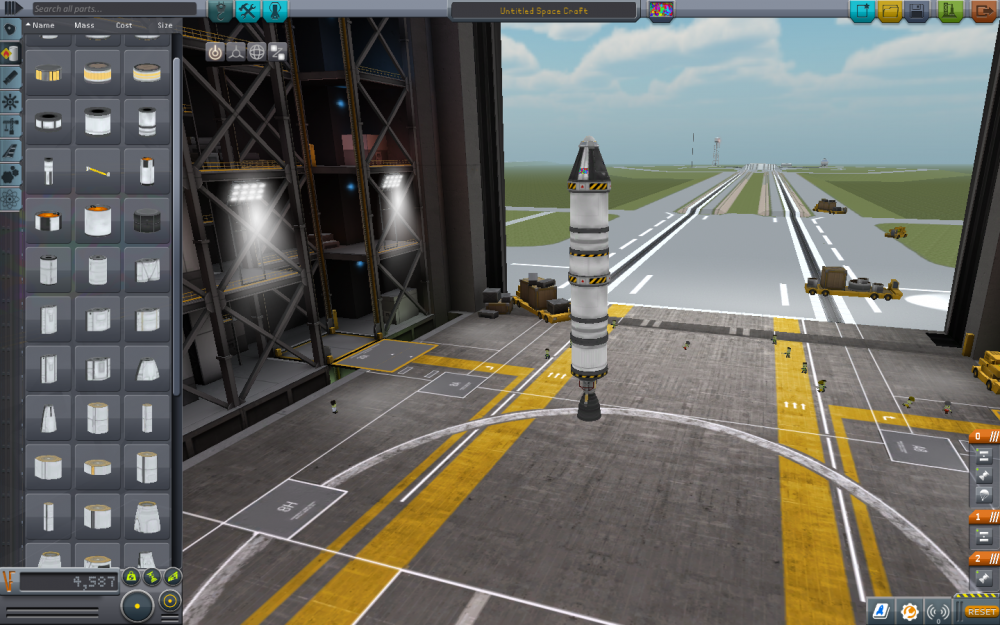
esmith
Members-
Posts
44 -
Joined
-
Last visited
-
Days Won
1
esmith last won the day on January 20 2016
esmith had the most liked content!
Recent Profile Visitors
esmith's Achievements
Newbie (1/14)
1
Reputation
-
Team Name: ZZ Smith Research Available Funds: 76,852 Vehicle Name: Disco Stick Mahfk 1 Vehicle Parts: MK1 Command Pod Rockomax 64 Fuel Tank RE-M3 Mainsail Engine Rockomax Decoupler Rockomax X32 Fuel Tank LV-909 Terrier Engine TR-18A Decoupler Rockomax X-200-8 Fuel Tank LT-1 Landing Struts Mk16 Parachute Pegasus Mobility Enhancer Total Cost: 34,672 Design Goals: The big fuel tanks and powerful engine on the bottom will get the craft into orbit. Once in orbit, it will decouple and the smaller, more efficient engine will get us to the moon and the even smaller engine will get us to land on it and back. The parachute will give us safe reentry. Launch Goals: This rocket must get us to the moon. Pilot Plan: The pilot will guide the craft into orbit and land it on the moon and be the first Kerbal to walk on the moon and return safely.
-
Time of launch: 10:32 Team members present: Ethan Smith, Zachary Zlotnick Play by play: The world watched breathlessly as renowned screw-ups attempted to be the first to launch a satellite into space. As the craft lifted off everyone watching thought for sure that the craft would begin to tip and plow into the ground. However, the path of the craft remained stable and straight as an arrow. Upon entering the thinner part of the atmosphere, the craft was turned so that it could achieve a periapsis of above 70,000 meters. Once at periapsis, the craft burned its remaining fuel to get into orbit. The satellite was then detached and left to float in stable orbit. Time of flight: 20 minutes 15 sec Summary: For once we achieved our stated goal by putting a satellite into orbit. Opportunities, learnings: We learned that if you try enough times, you will eventually succeed, as even a stopped clock is right twice a day. We learned that our space program is not necessarily doomed to fail and that we are not worthless human beings. Our next mission will be even more ambitious and reflect our newfound self-confidence. Strategies/timelines: We will shoot for the moon as soon as possible, but not without proper research and planning. We learned our lesson from the last times. Milestones: First satellite in stable orbit – 80,000 Achieved stable orbit – 10,000 Available funds: 106,617
-
Team Name: ZZ Smith Research Available Funds: 31,737 Vehicle Name: Dave Matthews Vehicle parts: Part Quantity Price TT-38K Radial Decoupler 4 600 Stayputnik 1 300 FLT 400 Fuel tank 1 500 Stack Decoupler TR 18 A 1 400 LVT 30 Reliant liquid fuel engine 5 1100 FL-T 200 4 422 FL-R25 RCS Fuel Tank 1 600 Z-1K Rechargeable Battery Pack 1 880 RV-105 RCS Thruster Block 4 620 Design Goals: This craft is designed to get a satellite into orbit. The initial four rockets will get the craft out of the thick part of the atmosphere and once they are jettisoned the second stage will be activated to get the craft into stable orbit. The rechargeable battery pack will allow the satellite to function for several orbits. Launch Goals: We are going to put a satellite into orbit. There will be no Kerbals harmed in this launch. Pilot Plan: There will be no pilots in our space program until we can prove that we are capable of not being screw ups.
-
Time of launch: 10:42 Members present: Ethan Smith, Zach Zlotnick Play by play: The rocket was launched and accelerated to around 300 m/s. A gravity turn was executed to give the craft a parabolic path and it was ensured that the heading of the rocket lined up with the velocity vector so that torques exerted by air resistance was minimized. The rocket burned through its fuel too quickly and we ran out at 25 km and the first stage was jettisoned. The craft continued to its peak where a maneuver was added to attempt to get the craft into orbit. There was not sufficient fuel to get the Kerbal into stable orbit. The craft got exceedingly close, however, so it will be trapped in space for the foreseeable future. The brave pilot is not dead, and we hope that we can advance our program enough that we might one day rescue him. If not, he will eventually descend back to Earth. Time of flight: Still ongoing Summary: We were within one kilometer of achieving stable orbit, so the failure to do so is a crippling blow to our space program’s morale. Next time we will build a better rocket that will make it into orbit and beyond. Opportunities and learnings: Our fatal flaw was that we did not change the rocket design enough from our last launch. It was still fundamentally flawed in that it didn’t have enough fuel. Our next rocket will be built by a different engineer who will know what he’s doing and give us the best possible spacecraft whatever the cost. Strategies/timelines: We are running out of chances to get into orbit. Another failure will not be tolerated by our program. Next time we will get into orbit or die trying. Milestones: None Available funds: 61,059
-
Team Name: ZZ Smith Research Available Funds: 65,271 Vehicle Name: Big Daddy Mark II Vehicle parts: Part Quantity Price LV909 Terrier Liquid Fuel Engine 1 390 MK1 Command Pod 1 600 FLT 400 Fuel tank 1 500 Stack Decoupler TR 18 A 2 400 LVT 30 Reliant liquid fuel engine 1 1100 MK16 Parachute 1 422 FL T800 Fuel Tank 2 800 Design Goals: The bottom part of the rocket will make the craft go high then will be decoupled once it runs out of fuel. The secondary engine will get the command pod into orbit and back. The heat shield and parachute will allow the craft to reenter safely hopefully. Launch Goals: The goal of this mission is to get a Kerbal into orbit and back home safely so his wife and kids are not abandoned. They do not have a life insurance policy, so if he were to die, it would bring financial hardship to that household. Pilot Plan: The pilot will fly the craft and once it reaches 100 m/s he will begin to turn the craft to 10 degrees. This will cause gravity to bend the path of the rocket as it accelerates. Once the first stage runs out, the pilot will jettison the initial booster and fuel tanks and activate the second stage. The secondary booster will provide acceleration into space and from there the craft will burn into orbit. Hopefully enough fuel will be left to get home, in which case the pilot will have to keep the heat shield going against the atmosphere and use the parachute to not crash into the ground at high speed.
-
Time of Launch: 10:30 AM Team members present: Ethan Smith, Zach Zlotnick Play by play: The rocket was launched and accelerated to around 300 m/s. A gravity turn was executed to give the craft a parabolic path and it was ensured that the heading of the rocket lined up with the velocity vector so that torques exerted by air resistance was minimized. The rocket burned through its fuel too quickly and we ran out at 25 km and the first stage was jettisoned. The craft continued to its peak where a maneuver was added to attempt to get the craft into orbit. There was not sufficient fuel to get the Kerbal into stable orbit. Upon running out of fuel, the craft began to descend back to Earth. Although it did not burn up in the atmosphere, it did crash into some very tall mountains thus killing poor Jeb and leaving his family without a source of income. We express our sincerest regrets to the family of our Kerbal astronaut and we will pay any fines imposed. Time of flight: 15 minutes 20 sec Summary: We were within a few kilometers of achieving stable orbit and it was disheartening not to reach it. No milestones were achieved and a Kerbal lost his life unnecessarily. Next time, we will try to land the craft on the light side of the planet, so we can see any mountains that might pose as obstacles. Opportunities, learnings: We learned that we are very close to achieving orbit and with a few design tweaks we will be able to send a Kerbal safely into orbit. Space travel is very serious business and we will not lose another Kerbal. Strategies/ Timeline: Tomorrow we going into orbit, boi. The loss of life was regrettable, but great strides were made in science today that will help our space program be the first to reach orbit. We just need to be more fuel efficient so that we have enough fuel to get to orbit and back. Milestones: none Available funds: 65,271
-
Team Name: ZZ Smith Research Available Funds: 71,183 Vehicle Name: Big Daddy Vehicle parts: Part Quantity Price LV909 Terrier Liquid Fuel Engine 1 390 MK1 Command Pod 1 600 FLT 400 Fuel tank 1 500 Stack Decoupler TR 18 A 2 400 LVT 30 Reliant liquid fuel engine 1 1100 MK16 Parachute 1 422 FL T800 Fuel Tank 1 800 Design Goals: The bottom part of the rocket will make the craft go high then will be decoupled once it runs out of fuel. The secondary engine will get the command pod into orbit and back. The heat shield and parachute will allow the craft to reenter safely hopefully. Launch Goals: The goal of this mission is to get a Kerbal into orbit and back home safely so his wife and kids are not abandoned. The ship will be launched then execute a slight gravity turn so that it follows a parabolic path at the apex of which it will execute a maneuver that will send it into orbit. They do not have a life insurance policy, so if he were to die, it would bring financial hardship to that household. Pilot Plan: The pilot will fly the craft into orbit and try not to die as we hold his fragile life in our clumsy hands.
-
Time of Launch: 10:48 Team members present: Ethan Smith, Zach Zlotnick Play by play: The rocket launched and appeared on its way, but then started to tip and could not be righted so the mission was aborted and the Kerbal was brought back to Earth before he could be fatally injured. Time of flight: 8 minutes Summary: This mission was a complete failure and an embarrassment for this organization. Clearly, our lack of scientific knowledge as a team consisting of a poker player and a pop star is a disadvantage. No goals were achieved, but we have learned from our mistakes and no Kerbals were harmed. Our next mission will undoubtedly be more successful. Opportunities, learnings: We learned that building a really tall top heavy rocket is a bad strategy and this will be reflected in our next design. Strategies/ Timeline: We will put a Kerbal into orbit and we will put a Kerbal on the moon by the end of the decade. There is a lot of work to do before we will be ready to put a Kerbal into orbit. We will put more effort into research and development so our next mission will succeed. Milestones: none Available funds: 71,183
-
Team Name: ZZ Smith Research Available funds: 74,389 Vehicle Name: Dave the Chariot of Fire Vehicle parts: Part Quantity Price LV909 Terrier Liquid Fuel Engine 1 390 MK1 Command Pod 1 600 FLT 400 Fuel tank 4 500 Stack Decoupler TR 18 A 2 400 LVT 30 Reliant liquid fuel engine 1 1100 MK16 Parachute 1 422 Small Delta Wing 4 200 Total Cost: 6412 Design Goals: The liquid fuel and engine on the bottom are designed to get the craft up to a high altitude and will be jettisoned once those fuel tanks run out. The smaller tank and engine attached directly to the command pod will get the craft into orbit and should provide enough reserve fuel to get the craft back out of orbit by burning retrograde and causing the craft to descend harmlessly to the planet thanks to the parachute and heat shield which will minimize risk of burning up or crashing and dying. Launch Goals: We will get a Kerbal into orbit. This will be done by launching a rocket really high at an angle and then activating thrusters when the craft reaches its apex causing the craft to go into orbit. Pilot Plan: The brave Kerbal space pilot will fly the craft and be in charge of not dying and enjoying the view of his beautiful home planet from above. He will hopefully not die.
-
Time of launch: 10:50 EST Members Present: Ethan Smith, Zach Zlotnick Play by play: At first it seemed that the rocket was burning through its fuel too quickly but after curtailing the thrust, the ship was easily able to attain 10 km. Upon descent, it seemed that the pilot might perish, but the parachute, was able to slow his descent to 6 m/s, which apparently was slow enough to spare his miserable Kerbal life. Time of flight: 6 minutes Summary: We successfully launched a craft to 10 km with a Kerbal aboard and brought him back safely. We achieved our goals and brought Kerbal-kind one step closer to greatness. This achieved the milestone of both having a launch to 10 km and a manned launch to 10 km. Given that the Kerbal survived, it would appear that all safety precautions were up to specs and we will continue to hold the same conscientious attitude toward Kerbal safety. Opportunities, learnings: We learned that space travel is extremely stressful and that we should not send a Kerbal into space so haphazardly. That being said, our hasty launch netted positive results, demonstrating that it is possible to circumnavigate some preparations in the name of speed. Strategies/ project timeline: We are more than capable of tackling the next milestone in the space race. However, our next craft, might be more complicated, lending itself to require more research and development. Milestone awards: Launch to 10 km –5000 Manned launch to 10 km–10000 Available funds: 74,389
-
Team Name: ZZ Smith Research Available Funds: 60,000 Vehicle Name: Your Mom Vehicle parts: MK1 Command Pod –600 RT-5 “Flea” Solid Fuel Booster –200 MK16 Parachute –422 Total cost: 1222 Design Goals: This vehicle is designed to get to 10 km in altitude. It was designed with simplicity to limit the possibility of technical malfunction, but it should function well enough while being cheap. Launch Goals: The goal of this mission is to get to an altitude of 10 km Pilot Plan: There will be a pilot just along for the ride hoping that he does not die.
-
Mankind likes big things. We like gigantic iPhones, Venti Lattes, and skyscrapers. The pyramids of Egypt represent perhaps man's earliest obsessions with making big things. As children, we stack wooden blocks until they topple and injure the cat. We are a species obsessed with bigness. But how big could we build? The current tallest building in the world is pretty big, but it's miniscule compared to the towering peak of Mt. Everest. The world's tallest buildings keep getting bigger, but eventually there comes a point when it is impossible to keep building upward. Or is there? In 1895, Konstantin Tsiolkovsky proposed a structure known as a space elevator. Such a structure would begin on Earth and stretch all the way out into outer space. But wouldn't it crumble under its own weight? Normally yes, but this isn't your average game of Jenga. A structure in orbit experiences an apparent centrifugal force that increases the farther out in space an object gets. How and why demands a separate blog post, but given that parameter, a structure as tall as a space elevator would be able to support its own weight because the top section would experience a net force outward that cancels out the gravity that would cause the structure to topple. Therefore, it would theoretically be possible to create a space elevator. Unfortunately, there would still be a ton of forces involved, making most materials useless. However, scientists have postulated that carbon nanotubes might be strong enough to be used in such a project. Even so, the space elevator is a long ways away, but should it come to fruition, it would make transporting packages into space immensely less expensive. Plus, it would probably look awesome.
-
Last weekend I attended the high school's production of All Shook Up. It was a nice show but a few things stood out to me. The first was that the string of lights they used in the abandoned fairgrounds scene was wired in parallel. Some of the lights were out, but the rest still shone on, because there was still a path for current to get from one bulb to the other, whereas in a series configuration, a dead bulb would block all current flow and cause the all of the remaining bulbs to go dark. Props to the mayor from springing for the nicer lights. Maybe I can use this as leverage for my mother to finally get better Christmas lights. Another thing I noticed was a sign posted on an outside wall of the school. The sign said something to the effect of "security cameras may or may not be monitored at any time." Of course, my "sign language" skills are not the best, so some of the effect is lost in translation. However, the sign did make me wonder: if it is impossible to know whether a security guard is watching the cameras, then does that mean they exist in a superimposition of both states à la Schrodinger's cat? It has essentially the same setup, as we cannot know if the cameras are being monitored without "opening the box." Perhaps the sign should say, "security cameras are both monitored and not monitored at all times." But the real question here is, does the security guard get paid for all that time he was both working and not working? These are the problems imposed by quantum physics.
-
If you've ever driven late at night with an irresponsible teenage driver, you've most likely involuntarily been a part of some pretty crazy car stunts. The good old fashioned Tokyo drift and doughnut are classic examples of things that should not be done with a car. But like most things that are bad for you, they are pretty cool. A stunt that doesn't get a lot of love is the wheelie. It's one thing to pop one on a bike or a Razor scooter, but to do it with a four-wheeled car is on a whole other level. Of course, it's too dangerous and also impossible for non-professional drivers, but how is it done? Well the most important part of popping a wheelie is to get tons of torque on the rear axle. By accelerating the car forward at a great rate, a torque is applied that counteracts the torque provided by the center of mass of the car. Once the torque gets great enough, the front axle bears none of the weight of the car and begins to tip upward. Motorcycles are easier to wheelie because they are shorter, making their center of mass closer to the axle, and requiring less torque. Conversely, popping a wheelie in a longer, heavier car is more difficult unless it has a much more powerful engine. What makes wheelies very dangerous is that if the acceleration stops the car will fall very hard onto the ground and possibly explode (I have no background in automobiles, but I'm pretty sure that's how it works), or at the very least damage the car and people in it. So don't try to pop a wheelie until you're old enough to get your stunt driver's license. Until then, always drive the speed limit and wear a seat belt.
-
Possibly the coolest form of transportation is undoubtedly trains. They're just so darn cool. While some might write off trainsportation as a relic of the days of Manifest Destiny, it's actually becoming much more useful and cool thanks to science. The newest generation of trains does not run on short men in conductor hats shoveling coal into an engine: they run on magnetism. The trains work by strapping a very powerful magnet onto the bottom of the train and having another very powerful magnet in the tracks. The magnetic force between the two allows the train to hover above the tracks. This eliminates the friction of a traditional train and allows it to reach incredibly high speeds of up to 500 km/h (about 310 mph for those who don't believe in the metric system). The train moves because the magnets are electromagnets. This means they can be turned on and off by running a current through them. The train is propelled forward by magnetic fields in front of and behind it on the tracks that push and pull in forward respectively. These new trains are being put into use all over the world, most famously in Japan where they are known as bullet trains (because they go fast). While these trains will probably never come to America because of our crippling inability to fix or improve any of our infrastructure, they are still pretty cool and mark a significant comeback for trains everywhere, and it's all thanks to physics.
Terms of Use
The pages of APlusPhysics.com, Physics in Action podcasts, and other online media at this site are made available as a service to physics students, instructors, and others. Their use is encouraged and is free of charge. Teachers who wish to use materials either in a classroom demonstration format or as part of an interactive activity/lesson are granted permission (and encouraged) to do so. Linking to information on this site is allowed and encouraged, but content from APlusPhysics may not be made available elsewhere on the Internet without the author's written permission.
Copyright Notice
APlusPhysics.com, Silly Beagle Productions and Physics In Action materials are copyright protected and the author restricts their use to online usage through a live internet connection. Any downloading of files to other storage devices (hard drives, web servers, school servers, CDs, etc.) with the exception of Physics In Action podcast episodes is prohibited. The use of images, text and animations in other projects (including non-profit endeavors) is also prohibited. Requests for permission to use such material on other projects may be submitted in writing to info@aplusphysics.com. Licensing of the content of APlusPhysics.com for other uses may be considered in the future.





